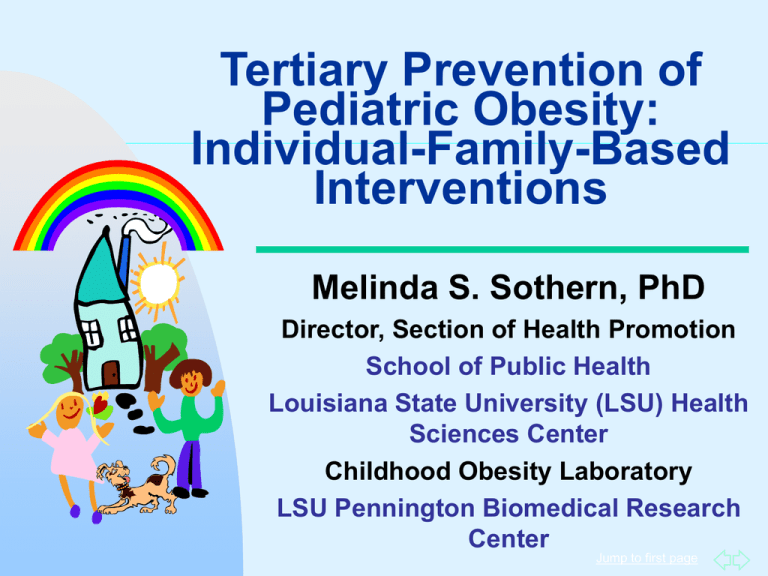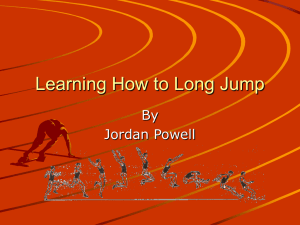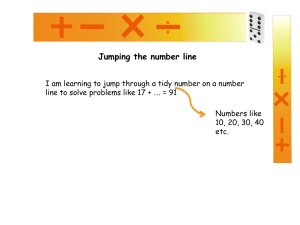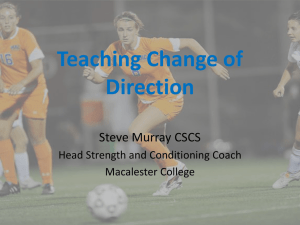ADA_Hawaii_Sothern_03_NOV_06
advertisement

Tertiary Prevention of Pediatric Obesity: Individual-Family-Based Interventions Melinda S. Sothern, PhD Director, Section of Health Promotion School of Public Health Louisiana State University (LSU) Health Sciences Center Childhood Obesity Laboratory LSU Pennington Biomedical Research Center Jump to first page What should I do to help my overweight patient? Jump to first page Tertiary Prevention of Pediatric Obesity: Individual-Family-Based Interventions Designed to slow down or reverse the increase in BMI and to prevent the complications of overweight Included a measure of adiposity Included children >2 and <18 years of age Intervention of 8 weeks or more Included at least 30 subjects in the intervention group Surgery or pharmacological interventions were not evaluated. Jump to first page J Am Diet Assoc. 2006;106:925-945 What Does the Research Say? Studies from1984 to 2004 were evaluated 44 evidence-based studies were identified 29 were randomized-controlled (RCT); 15 other design 43 contained one or more component (multi-component) 39 included behavior counseling; 6 studies > 2 years 38 studies included dietary counseling w/behavior & exercise J Am Diet Assoc. 2006;106:925-945 Jump to first page Childhood Obesity Treatment Long-term Studies Authors Age Intervention Outcome Epstein 6-12 Parent/child -19.7% @ 10 yrs Braet 9-12 Behavioral vs advice -17.3 @ 4.5 yrs. Nuutinen 6-15 Group vs Individual -11.7% @ 5 yrs. Epstein 6-12 Parental obesity NS @ 10 yrs Epstein 6-12 Exercise + diet NS @ 10 yrs Epstein 6-12 Lifestyle exercise -15.3% @ 10 yrs Jump to first page What Does the Research Say? Family based interventions (Grade I & II): 21 of the 29 RCT 13 or the 15 studies of other design 28 studies - significant weight loss Parent training within multi-component interventions (Grade I & II): 20 of the 29 RCT 13 of the 15 studies of other design 10 studies evaluated child only versus parent only or parent/child combined Jump2006;106:925-945 to first page J Am Diet Assoc. Treatment of Overweight Conditions in Childhood Pediatrician Behavioral Counseling Family Nutrition Education Exercise and physical activity Jump to first page Multi-Disciplinary Weight Management Sample Class Schedule Medicine Nutrition Behavior Exercise Return Calls Set-up 4:00-4:30 4:30-4:50 Nurse Supervises Weigh-In Check Food Records Talk with Parents Review Charts Check Exercise Cards 4:50-5:10 Group Group Group Group Review Charts Behavior Session Return Calls Review Charts Review Charts Return Calls 5:30-6:00 Physician Q&A or Session Clean-up Nutrition Session Set-up Exercise Clean-up 6:00-6:30 Physician Q&A or Session Exercise Session 6:30-7:00 Clean-up 5:10-5:30 Clean-up Jump to first page What is the Best Dietary Approach for Treating Overweight Children? Jump to first page Recommendations from the American Academy of Pediatrics Health supervision (Nutrition) Encourage, support, and protect breastfeeding. Encourage parents and caregivers to promote healthy eating patterns by offering nutritious snacks, such as vegetables and fruits, low-fat dairy foods, and whole grains; encouraging children’s autonomy in self-regulation of food intake and setting appropriate limits on choices; and modeling healthy food choices. Jump to first page American Academy of Pediatrics. Pediatrics. 2003;112(2):424-430. What Does the Research Say? Dietary Counseling/Nutrition Education within multi-component (Grade I & II) 38 studies- significant reductions in adiposity (24 RCTS; 14 other design) 29 nutrition education such as portion control and reductions of high density foods 12 Traffic Light diet 7 diets based on ADA guidelines 5 balanced hypocaloric Jump2006;106:925-945 to first page J Am Diet Assoc. What is the best type of physical activity for overweight children? Jump to first page Recommendations from the American Academy of Pediatrics Health supervision (Physical Activity) Use change in BMI to identify rate of excessive weight gain relative to linear growth. Routinely promote physical activity, including unstructured play at home, in school, in child care settings, and throughout the community. Recommend limitation of television and video time to a maximum of 2 hours per day. Jump to first page American Academy of Pediatrics. Pediatrics. 2003;112(2):424-430. What Does the Research Say? Physical Activity Interventions (Grade I & II): 24 RCTs; 13 other design 10 RCTs examined the independent contribution of exercise: 8 showed significant reductions in adiposity independent of other factors 1 randomized-controlled study examined sedentary behavior (TV) versus increased physical activity (Grade III) to first page J Am Diet Assoc.Jump 2006;106:925-945 What Does the Research Say? Behavioral counseling interventions (Grade I & II): 25 RCTs; 14 other design 7 RCT’s compared behavioral counseling to standard care All showed significant reductions in adiposity compared to standard care Many were based on well-established theories Most included basic behavioral techniques Only 2 studies examined the independent contribution of different techniques Jump to first page J Am Diet Assoc. 2006;106:925-945 Behavioral Treatment Strategies Monitoring of Diet and Activity Redirection & Give Choices Positive Attention Cue Elimination & Stimulus Control Limits Setting & Consistency Goal Setting & Action Planning Goal Review Modeling Relapse Prevention Jump to first page Summary Recommendations: Individual-and Family-Based Tertiary Treatment of Pediatric Obesity Recommendations: Family-based, multi-component interventions should be routinely recommended As part of a family-based, multicomponent program the following are recommended: Parent training Dietary counseling/nutrition education Physical Activity Behavioral Counseling Jump to first page J Am Diet Assoc. 2006;106:925-945 Summary Recommendations: Individual-and Family-Based Tertiary Treatment of Pediatric Obesity Recommendations: Limited evidence to support routine recommendation of: Individual-based intervention Altered macronutrient approaches Sedentary behaviors alone Lack of evidence to support any recommendation of: Individual psychotherapy Jump to first page J Am Diet Assoc. 2006;106:925-945 A lot can happen in 2 years! Jump to first page Clinic-based Studies 1985-2005 Interventions for Childhood Overweight: Evidence for the US Preventive Services Task Force Recommendations: Insufficient evidence for the effectiveness of behavioral counseling or other preventive interventions with overweight children and adolescents that can be conducted in primary care settings or to which primary care physicians can make referrals. More quality research is needed. to first page Whitlock, Williams, Gold, et alJump Pediatrics, 2005 Evidence-based Recommendations for Physical Activity in School-Age Youth School-age youth should participate daily in 60 minutes or more of moderate to vigorous physical activity that is: Developmentally appropriate Enjoyable Involves a variety of activities Jump to first page 2005 Strong, Malina, Blimkie, et al, J Pediatrics, Evidence-based Recommendations for Physical Activity in School-Age Youth – Type Pre-school Years: General movement activities (jumping, throwing, running, climbing) Pre-pubertal (6-9 years): More specialized and complex movements, anaerobic (tag, games, recreational sports) Puberty (10-14 years): Organized sports, skill development Adolescence (15-18 years) More structured health and fitness activities, refinement of skills Strong, Malina, Blimkie, et al,JumpJ Pediatrics, to first page 2005 Evidence-based Recommendations for Physical Activity in School-Age Youth Intensity 5 to 8 METs (moderate to vigorous) is need to derive most health benefits, such as active outdoor play, brisk walking, cycling. Duration A total of 60 minutes per day Cumulative, not necessarily sustained Frequency Daily Jump to first page 2005 Strong, Malina, Blimkie, et al, J Pediatrics, Evidence-based Recommendations for Physical Activity in School-Age Youth - Type Physically inactive youth: Incremental approach to reach the 60 minute per day recommendation Increase activity by 10% per week Progressing too quickly is counter productive and leads to injury Jump to first page 2005 Strong, Malina, Blimkie, et al, J Pediatrics, Evidence-based Recommendations for Exercise in Overweight Youth Type or Mode Play oriented in younger children Continuous movement games, exercise machines, swimming, aerobic dance, strength training in older children Intensity 60-80% Max HR (moderate to vigorous) Duration and Frequency 30-50 minutes per session at least 3 days per week Jump to first page Owens, Handbook of Pediatric Obesity: Clinical Management, 2006 Physical Activity Studies 2004 Systematic Review and Meta Analysis 645 manually searched, 45 considered, of which 14 studies included (N = 481 overweight boys and girls, ~12 yrs). Few studies were robust. Recommendations: Aerobic exercise of 155-180 min/weeks at moderate-to-high intensity is effective for reducing body fat in overweigh youth. Effects on body weight and central obesity are inconclusive. Jump J to Ob, first page Atlantis, et al, Int’l 2006 Strength Training Improves Lean Muscle and Bone Mineral Content Obese, prepubertal children ~ 10 yrs; randomized to Diet alone (n = 41) (control group). Diet plus strength training (n = 41) (training group) 75-minute strength exercise 3 times/wk After 6 weeks, the children in the training group showed significantly larger increases in: Lean body mass (+ 0.8 kg [2.4%] vs. +0.3 kg [1.0%], p < 0.05) than control group Total bone mineral content (+46.9 g [3.9%] vs. +33.6 g [2.9%], p < 0.05) than control group Jump to firstRes, page 2005 Yu, et al, J Strength Cond Initial Physical Activity Strategies by Medical History, Age & Weight Condition Level Age Physical Activity Approach Normal Wt Obese Parent 6 Family counseling, fitness education, free play, reduce TV, parent training >85th BMI Structured weight bearing activities, free 7-18 play, reduce TV, parent training >95th BMI Alternate non-weight bearing activities, free 7-18 play, reduce TV, parent training >99th BMI 7-18 *Non-weight bearing activities, free play, reduce TV, parent training *Close medical supervision required. Jump to first page Summary: First ADA position paper— to draw its conclusions from an extensive review of the literature to use evidence analysis approach c enter for eight & ealth h University Jump to firstof California, page Berkeley Benefits of this new approach Provides more rigorous standardization of review criteria Minimizes the likelihood of reviewer bias Increases the ease with which disparate articles may be compared Jump to first page First ADA position paper on pediatric overweight intervention at each level: IndividualFamilySchoolCommunity Jump to first page Levels for Childhood Obesity Prevention Legislation Media Urban Design & Transportation Systems Food Supply Community Healthcare System Schools Home & Family The Child c enter for eight & ealth h Developed by Center for Weight and Health, UC Berkeley University Jump to firstof California, page Berkeley First position paper to include 3 types of intervention Tertiary Slow down or reverse the increase in BMI and to prevent the complications of overweight Secondary Identification and intervention of asymptomatic children who are at risk for overweight Primary Prevention efforts occurring before individuals are overweight c enter for eight & ealth h University Jump to firstof California, page Berkeley Evidence grades c Grade I: Good – evidence is consistent from studies of strong design Grade II: Fair – Evidence from studies of strong design is not always consistent or evidence is consistent but based on studies of weaker design Grade III: Limited – evidence from a limited number of studies Grade IV: Expert Opinion Only – no or limited studies but based on expertise Grade V: Not Assignable – no studies enter for eight & ealth h University Jump to firstof California, page Berkeley Key results Multicomponent family-based tertiary prevention programs for children ages 5 to 12 years – Grade I c enter for eight & ealth h University Jump to firstof California, page Berkeley Components of individual and family based intervention Behavioral Counseling Physical Activity Tertiary Prevention Diet Counsel Nutr. Ed. Parent Training Adiposity Outcomes Jump to first page Key results Multicomponent school-based primary prevention programs for adolescents – Grade II c enter for eight & ealth h University Jump to firstof California, page Berkeley Components of School Based Intervention Nutrition Education Family Environment PA Education Primary Prevention Sedentary Behaviors (TV/video) PA Environ Adiposity Outcomes Jump to first page An added bonus… School-based Interventions at all grade levels have shown effectiveness in changing student knowledge, attitudes, and behaviors around food and activity c enter for eight & ealth h University Jump to firstof California, page Berkeley Dietetic professionals may use this position paper to educate: • Overweight interventions are more efficacious with young children 6-12 than older children. • Children can decrease their adiposity without weight loss by maintaining or stabilizing weight over time. Jump to first page • Schools based interventions can be efficacious for adolescents. • Community based and environmental interventions must be developed and evaluated. They have the capacity to reach the greatest number of children and their families. Jump to first page Body weight is an imprecise surrogate. Concrete and actionable indicators appropriate for interventions are: • dietary intake/nutritional status; • physical and sedentary activity levels; • self-esteem, body image, and other psychological markers of health; • blood pressure; • blood lipids; and • blood glucose concentration. Jump to first page Practitioners can use the position statement to: Synthesize the literature Educate others Design interventions Obtain support Justify programs c enter for eight & ealth h University Jump to firstof California, page Berkeley and to write grants and advocate for needed research in the areas of: Community-based programs, including studies of the impact of changes in the built environment, marketing, and policy on children’s eating and physical activity patterns Intervention studies in ethnically diverse populations Intervention programs with adolescents c enter for eight & ealth h University Jump to firstof California, page Berkeley www.adaevidencelibrary.com/ Jump to first page







